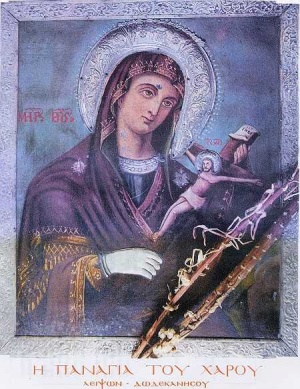Difference between revisions of "Panagia tou Harou"
m (It is the standardised name, this icon is one of a kind. refer to Wikipedia if you dont believe me.) |
|||
| (8 intermediate revisions by 5 users not shown) | |||
| Line 1: | Line 1: | ||
| − | |||
| − | |||
[[Image:panagia_tou_xarou.jpg|thumb|left|Icon of Panagia tou Harou]] | [[Image:panagia_tou_xarou.jpg|thumb|left|Icon of Panagia tou Harou]] | ||
| − | + | '''Panagia tou Harou''' is the name of the unique [[icon]] which depicts the [[Virgin Mary]] cradling the crucified Christ, rather than the Christ child, hence its name (''haros'' in Greek means "death"). This icon is found in the church of St. John the Theologian, Leipsoi (Greece). The annual commemoration of the icon takes place on [[August 23]] when the island of Leipsoi fills with pilgrims from all over the Dodecanese, to witness the procession of the icon around the entire island and see the annual blossoming of the dead bouquet of lilies on the icon. | |
| − | + | In the 1940s, a lady was praying to the "Panagia tou Harou" icon. Her prayers were answered, and in gratitude placed a simple bouquet of lilies on the icon. These lilies withered but remained on the icon. In the following year, at the [[leavetaking]] of the [[feast]] of the [[Dormition]] ([[August 23]]), these lilies blossomed again and gave off a fragrance. Since then, this [[miracle]] occurs annually on the day of the feast. | |
| − | In the 1940s, a | ||
| − | == See also == | + | ==See also== |
| − | *[[ | + | *[[Icons of the Theotokos]] |
| − | == External | + | ==External link== |
| − | *[[w:Leipsoi|Leipsoi on Wikipedia]] | + | *[[w:Leipsoi|''Leipsoi'' on Wikipedia]] to read more about the island |
[[Category:Icons]] | [[Category:Icons]] | ||
[[Category:Icons of the Theotokos]] | [[Category:Icons of the Theotokos]] | ||
[[Category:Theotokonymia]] | [[Category:Theotokonymia]] | ||
Latest revision as of 13:11, June 10, 2008
Panagia tou Harou is the name of the unique icon which depicts the Virgin Mary cradling the crucified Christ, rather than the Christ child, hence its name (haros in Greek means "death"). This icon is found in the church of St. John the Theologian, Leipsoi (Greece). The annual commemoration of the icon takes place on August 23 when the island of Leipsoi fills with pilgrims from all over the Dodecanese, to witness the procession of the icon around the entire island and see the annual blossoming of the dead bouquet of lilies on the icon.
In the 1940s, a lady was praying to the "Panagia tou Harou" icon. Her prayers were answered, and in gratitude placed a simple bouquet of lilies on the icon. These lilies withered but remained on the icon. In the following year, at the leavetaking of the feast of the Dormition (August 23), these lilies blossomed again and gave off a fragrance. Since then, this miracle occurs annually on the day of the feast.
See also
External link
- Leipsoi on Wikipedia to read more about the island
